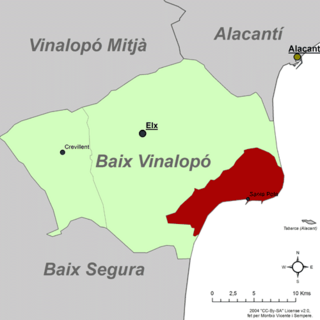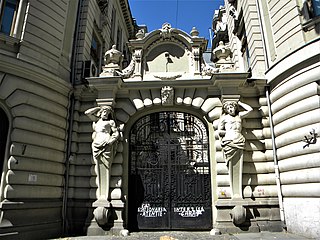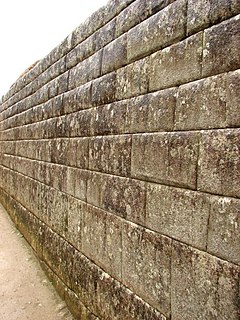
Alicante, or Alacant, both the Spanish and Valencian being official names, is a city and port in Spain on the Costa Blanca, the capital of the province of Alicante and of the comarca of Alacantí, in the south of the Valencian Community. It is also a historic Mediterranean port. The population of the city of Alicante proper was 330,525, estimated as of 2016, ranking as the second-largest Valencian city. Including nearby municipalities, the Alicante conurbation had 452,462 residents. The population of the metropolitan area was 757,085 as of 2014 estimates, ranking as the eighth-largest metropolitan area of Spain.

Marsala is an Italian town located in the Province of Trapani in the westernmost part of Sicily. Marsala is the most populated town in its province and the fifth in Sicily.

Santa Pola is a coastal town located in the comarca of Baix Vinalopó in the Valencian Community, Spain, by the Mediterranean Sea. It has an area of 58.6 km2 (23 sq mi) and has a population of 30,000 inhabitants of whom 10,000 are residents of the nearby town of Gran Alacant.
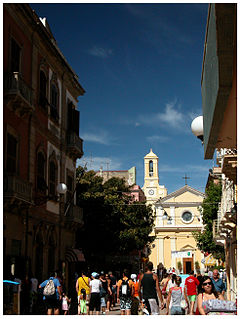
Carloforte is a fishing and resort town of located on Isola di San Pietro, approximately 7 kilometres off the southwestern coast of Sardinia, in the Province of South Sardinia, Italy.

The Basel city walls are a complex of walls surrounding the central part of the Swiss city of Basel, only partially preserved today. The first city wall was completed around 1080 under bishop Burkhard von Fenis. A newer wall was constructed around 1230, which is known as the Inner Wall. Its course was mostly identical to the Burkhard wall. In 1362 the construction of a larger wall complex began due to the city's expansion; it was completed in 1398, and is known as the Outer Wall. In 1859 the city's executives decided to raze the inner wall and gates to the ground. Three outer city gates and a short piece of the wall were saved from demolition and are being preserved as part of the city's heritage.
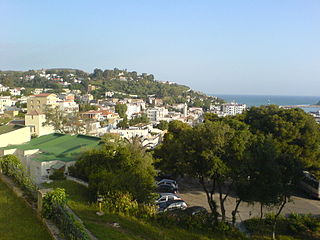
Tabarka is a coastal town located in north-western Tunisia, close to the border with Algeria. Tabarka's history is a colorful mosaic of Berber, Punic, Hellenistic, Roman, Islamic, Genoese and Turkish culture. The town is dominated by an offshore rock on which is remains a Genoese castle. Nationalist leader Habib Bourguiba, later president of post-independence Tunisia, was exiled here by the French colonial authorities in 1952. Tourist attractions include its coral fishing, the Coralis Festival of underwater photography, and its annual jazz festival.

Callosa d'en Sarrià (Valencian: [kaˈʎoza ðen sariˈa] is a Valencian town and municipality located in the comarca of Marina Baixa, in the province of Alicante, Spain, lying in the valley of the river Guadalest, 50 km from the city of Alicante. Callosa d'en Sarrià has an area of 24.8 km² and according to the 2003 census, a total population of 8,060 inhabitants. The economy of Callosa is chiefly based on tourism and agriculture: it is the main producer of loquat in Spain. The most important monuments in the town are the Catholic archipresbyteral church of Sant Joan Baptista, built in the 18th century, and the Fortress of Bèrnia, built in the 17th century at the top of a nearby mountain to defend the city from pirates and Moriscos.

Alicante–Elche Airport, originally named El Altet, is —as of 2017— the fifth-busiest airport in Spain based on passenger numbers, and the main airport serving the Valencian Community and the Region of Murcia. The airport is located in the municipality of Elche, about 10 kilometres east of this city and about 9 km (5.6 mi) southwest of Alicante. Its influence area spans other cities in the Valencia province—the city of Valencia is located about 160 km (99 mi) north of the airport—and in the Region of Murcia. The airport is located about 70 km (43 mi) north of Murcia.

Jalore Fort is the main attraction of Jalore, a town in the Indian state of Rajasthan, one of the nine castles of the Maru, under the Paramaras in the 10th century. It is one of the most famous and impressive forts in the state and has been known through history as the Sonagir or the ‘golden mount’.

The Boca Chita Key Historic District is a U.S. historic district within the Biscayne National Park in Miami-Dade County, Homestead, Florida. Located on the northwest section of Boca Chita Key, delimited by Biscayne Bay in the north and west and a half ruined stone wall on its southern side, it contains three historic buildings and the Boca Chita Lighthouse. On 1 August 1997, it was listed in the National Register of Historic Places for its architectural, historical and recreational values.
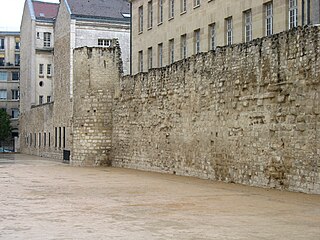
The Wall of Philip Augustus is the oldest city wall of Paris (France) whose plan is accurately known. Partially integrated into buildings, more traces of it remain than of the later fortifications which were destroyed and replaced by the Grands Boulevards.

The Walls of Dubrovnik are a series of defensive stone walls surrounding the city of Dubrovnik in southern Croatia. With numerous additions and modifications throughout their history, they have been considered to be amongst the great fortification systems of the Middle Ages, as they were never breached by a hostile army during this time period. In 1979, the old city of Dubrovnik, which includes a substantial portion of the old walls of Dubrovnik, joined the UNESCO list of World Heritage Sites.

The Atalaya Castle is a castle in Villena, province of Alicante, southern Spain. Located over a spur of the Sierra de la Villa, in the north-western part of the province of Alicante, it commands the former frontier between Castile and Kingdom of Aragon.
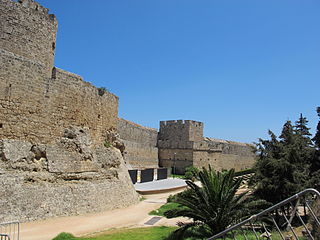
The fortifications of the town of Rhodes are shaped like a defensive crescent around the medieval town and consist mostly in a modern fortification composed of a huge wall made of an embankment encased in stone, equipped with scarp, bastions, moat, counterscarp and glacis. The portion of fortifications facing the harbour is instead composed of a crenellated wall. On the moles towers and defensive forts are found.

The fortifications of Valletta are a series of defensive walls and other fortifications which surround the capital city of Valletta, Malta. The first fortification to be built was Fort Saint Elmo in 1552, but the fortifications of the city proper began to be built in 1566 when it was founded by Grand Master Jean de Valette. Modifications were made throughout the following centuries, with the last major addition being Fort Lascaris which was completed in 1856. Most of the fortifications remain largely intact today.

The fortifications of Mdina are a series of defensive walls which surround the former capital city of Mdina, Malta. The city was founded as Maleth by the Phoenicians in around the 8th century BC, and it later became part of the Roman Empire under the name Melite. The ancient city was surrounded by walls, but very few remains of these have survived.
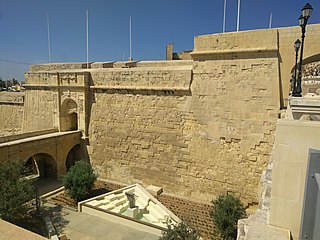
The fortifications of Birgu are a series of defensive walls and other fortifications which surround the city of Birgu, Malta. The first fortification to be built was Fort Saint Angelo in the Middle Ages, and the majority of the fortifications were built between the 16th and 18th centuries by the Order of Saint John. Most of the fortifications remain largely intact today.
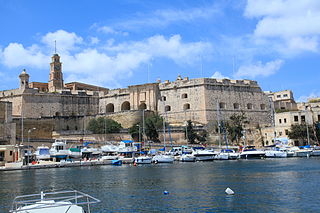
The fortifications of Senglea are a series of defensive walls and other fortifications which surround the city of Senglea, Malta. The first fortification to be built was Fort Saint Michael in 1552, and the majority of the fortifications were built over the next decade when it was founded by Grand Master Claude de la Sengle. Modifications continued until the 18th century, but large parts of the fortifications were demolished between the 19th and 20th centuries. Today, all that remain of Senglea's fortifications are the seaward bastions and part of the land front.
